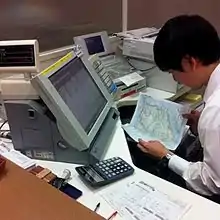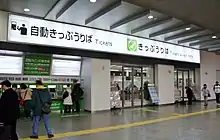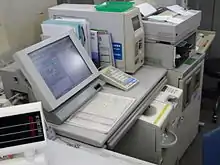MARS (ticket reservation system)
MARS (マルス, Marusu), which stands for Multi Access (originally Magnetic-electronic Automatic) seat Reservation System is a train ticket reservation system used by the railway companies of former Japanese National Railways, currently Japan Railways Group (JR Group) and travel agencies in Japan, developed jointly by Hitachi and the Railway Information Systems Co., Ltd (JR Systems), a JR Group company jointly owned by the seven members of the group.

Outline

The host computer of the system was previously located in Kokubunji, Tokyo until 2013, when it was moved to an undisclosed location in the northern part of the Kantō region.[1] The system is managed by JR Railway Information Systems since 1 April 1987.
Ticket offices at JR stations equipped with MARS terminals are called Midori no Madoguchi (みどりの窓口, literally "green window"), selling tickets of all JR Group trains and partly highway buses and route buses and ferries. It is possible for passengers to reserve tickets of buses and trains from one month prior to the given trip.
Currently the Midori no Madoguchi is named by JR Group.[2][3]
History
MARS-1
.jpg.webp)
The MARS-1 system was created by Mamoru Hosaka, Yutaka Ohno, and others at the Japanese National Railways' R&D Institute (now the Railway Technical Research Institute), and was built in 1958.[4] It was the world's first seat reservation system for trains, and entered service in February 1960, initially only providing bookings for the Kodama and Tsubame limited express services.[5] The MARS-1 was capable of reserving seat positions, and was controlled by a Hitachi mainframe transistor computer with a central processing unit consisting of a thousand transistors and a magnetic drum memory unit for data storage, which was where the MARS acronym originated from.[4]
In 2008, the MARS-1 system received a "One Step on Electro Technology -Look Back to the Future-" commemorative plaque from the Institute of Electrical Engineers of Japan.[6]
MARS 501

Introduced in stages between 2002 and 2004, the MARS 501 introduced the concept of an Ethernet-based client–server model. Also, the ticket paper type was changed to thermal paper.
MARS 505
The latest version of MARS uses the MARS 505 system which was introduced in April 2020, which expanded on contactless and ticketless boarding and booking capabilities brought along by the rise of mobile apps on smartphones and tablets.[7]
References
- "Archived copy". Archived from the original on 2023-06-28. Retrieved 2023-08-17.
{{cite web}}: CS1 maint: archived copy as title (link) - "List of the stations are installed for Midori no Madoguchi in JR East". Archived from the original on 2021-05-08. Retrieved 2021-06-02.
- "List of the stations are installed for Midori no Madoguchi in JR Hokkaido". Archived from the original on 2021-06-02. Retrieved 2021-06-02.
- "Hitachi and Japanese National Railways MARS-1". IPSJ Computer Museum. Information Processing Society of Japan. Archived from the original on 2016-10-27. Retrieved 2017-04-19.
- "Early Computers: Brief History". IPSJ Computer Museum. Information Processing Society of Japan. Archived from the original on 2017-05-02. Retrieved 2017-04-19.
- "Archived copy". Archived from the original on 2023-08-17. Retrieved 2023-08-17.
{{cite web}}: CS1 maint: archived copy as title (link) - "交通新聞 電子版|Jrシステム 新たなステージに対応 各種基盤整備の「マルス505」". Archived from the original on 2021-02-12.